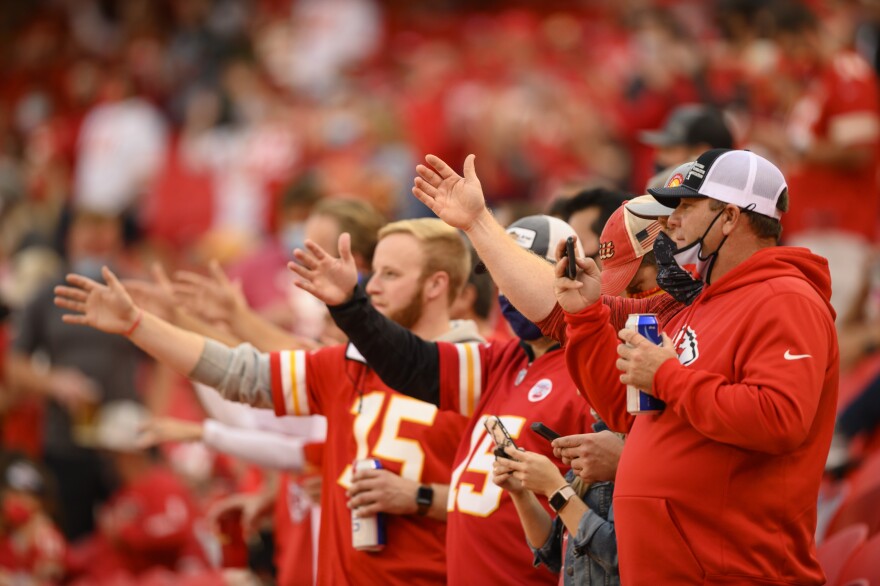Kansas Citians who drive the highways around the area know billboards and signs featuring players or logos of the Chiefs are plentiful.
But where I-435 flies over East 104th Street, just west of the Blue River, a new billboard has appeared. It’s red with yellow and white lettering, like so many others. Except this one says, “Change the name and stop the chop.”
Gaylene Crouser is the executive director of the Kansas City Indian Center and an enrolled member of the Standing Rock Sioux Tribe.
Her organization paid for the billboard.
When she first moved to Kansas City as a young adult, Crouser was appalled to see the Chiefs’ name and logo emblazoned everywhere, and the so-called tomahawk chop performed ad nauseam.
“I’m like, ‘Wow, how is this still a thing?’ If it was any other race of people, it wouldn’t be,” she said.
The Chiefs’ name and the chop have been called out since at least 2005.
That’s when a local group led by Acoma Pueblo activist and Haskell Indian Nations University professor Rhonda LeValdo started protesting the annual Kansas City-Washington matchup. At the time, the D.C. team was still using an offensive, seven-letter word for its name.
This year, Crouser says protesters have turned out to every home game that wasn’t at night.
“You know, we can have a dozen or 20 people protesting out there, but we’re not getting much publicity for it,” she said.
Meanwhile, Crouser said, the team can buy consultants and pay public relations experts, and release official-sounding statements.
“They are doing their best to make it look like it’s all hunky-dory,” she said.
And if you look at the Chiefs website, you’ll see what some consider the team’s attempt to redirect the narrative.
It has an entire section called “Celebrating American Indian Heritage,” with bright photos, words about how the organization has educated fans, and a long list of tribes that have participated in the team’s American Indian Heritage Month, which is in November.
At a press conference last August, team CEO and Chairman Clark Hunt said the organization has been engaged in seven years of learning, much of it facilitated by the team’s American Indian Community Working Group.
“We learned that the face paint and the headdresses were a big issue for the tribes … and of course this summer we took the next step, which is outright banning them,” he said.
KCUR contacted The Chiefs for an interview, but no one was made available.
We also reached out to several members of the American Indian Community Working Group, but interviews were turned down or cancelled.
“We know the issues that they care about,” Hunt said of the Working Group members in August. “The name, and the name of the stadium are not things that are high on their list.”
As for the tomahawk chop, it’s unclear if members of the Working Group see it as an issue.
According to a new study from the University of Michigan, 65% of Native Americans who frequently engage in tribal or cultural practices take offense at the chop.
In December, the National Congress of American Indians, which has worked with the Chiefs before, called the team out specifically.
In a resolution against race-based mascots, names and practices, they wrote that the “decision of the Kansas City Chiefs to prohibit fans from wearing headdresses and face paint … indicates that management understands the negative social impact of their brand.”
In August, Hunt acknowledged more changes may be in the works.
“I'm sure there'll be some steps down the road we take on other things related to our game day production,” he told reporters.
For now, the Chiefs find themselves on a shrinking list of American pro teams using American Indian-themed names, including the hockey team in Chicago and Atlanta’s baseball team.
The Chiefs may have a little time yet, though.
Katherine Fox at the Kansas City Sports Commission said the team’s success has only been a boon for the city’s image, at least when it comes to attracting national-level sports events.
But global brand and marketing strategist Katherine Wawner says if the team doesn’t continue to evolve, it’ll eventually hurt its bottom line.
Wawner is a director at APCO Worldwide, an advisory and advocacy communications consultancy. She said the recent trend toward social justice isn’t really a trend, because it’s not going away.
“This is something that's always kind of been here,” she said. “As we move forward into a more progressive society and a more just society, the only thing that you're seeing is more people getting on board.”
Copyright 2021 KCUR 89.3. To see more, visit KCUR 89.3. 9(MDA1MjI2NzUxMDEyNzQyMTY5MjQ2YzkwNA004))



